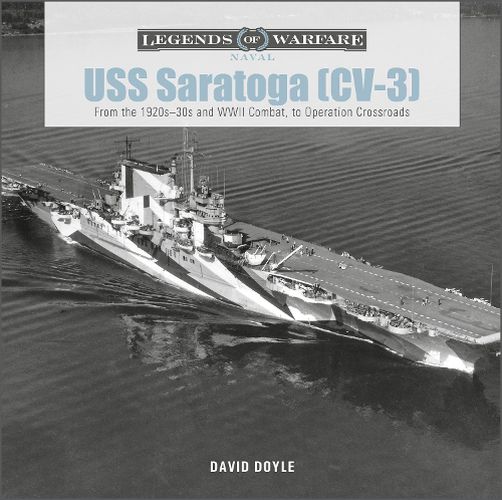USS Saratoga (CV-3): From the 1920s - 30s and WWII Combat, to Operation Crossroads
David Doyle

USS Saratoga (CV-3): From the 1920s - 30s and WWII Combat, to Operation Crossroads
David Doyle
An illustrated history of one of the US Navy’s earliest aircraft carriers. USS Saratoga and her sister ship USS Lexington were the two largest aircraft carriers in the world until 1944. The keel of the battle cruiser USS Saratoga (CC-3) was laid by New York Shipbuilding in Camden, New Jersey, on September 25, 1920. Work on the fast, formidably armed battle cruiser was suspended in February 1922, when the Washington Naval Conference negotiated limits on warship sizes and numbers. Once the accord was signed, the decision was made to covert the 28 percent complete Saratoga into an aircraft carrier (the same fate befell her sister ship, Lexington). Launched as an aircraft carrier on April 7, 1925, she became the largest ship of that type afloat. Saratoga’s revolutionary turboelectric drive and hull design allowed her to operate at 33 knots (either forward or backward), a trait believed to be useful in the event of combat damage to either end of her flight deck. And damaged she was. Though in port at San Diego, California, when the Japanese attacked Pearl Harbor, during the ensuing war the ship was damaged repeatedly, and sometimes severely. Despite this, she fought throughout the war, earning eight battle stars. Following the war, in view of her age, past damage, and the limitations of her design, Saratoga was deemed surplus and was expended as a target during the Bikini Atoll nuclear tests. She survived the first Able bomb test but was sunk by the Baker test on July 25, 1946. This 144-page volume, an expansion of the author’s earlier work, immerses the reader in the construction and operation of the ship at peace and war, as well as detailing the many refits and repairs she underwent, through over 350 photos and illustrations. AUTHOR: Since 1999, David Doyle has written over 200 published books, and the range of topics has expanded to include warships and combat aircraft. These books have ranged in size from 56 pages to large works approaching 1,000 pages. SELLING POINTS: . Saratoga was one of only three US aircraft carriers in service on December 7, 1941, to survive the war . The ship was sunk at Bikini Atoll in 1946, where it was used as a target for nuclear weapons testing . Saratoga was heavily damaged several times during the Pacific War, including by kamikaze strikes 360 colour and b/w photographs
This item is not currently in-stock. It can be ordered online and is expected to ship in approx 2 weeks
Our stock data is updated periodically, and availability may change throughout the day for in-demand items. Please call the relevant shop for the most current stock information. Prices are subject to change without notice.
Sign in or become a Readings Member to add this title to a wishlist.


